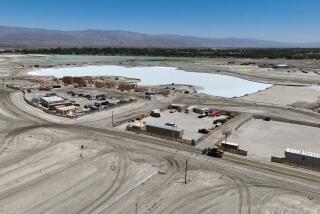Preservationists Seek New Life for Ghost Town
- Share via
SIMI VALLEY — There were glory days of Corriganville Park, times of Wild West celluloid shootouts and crowds cavorting on carnival rides, boat trips and picnics. People in Simi Valley want to bring those days back.
A Corriganville preservation movement, kept alive for years by a small band of locals, may achieve its goal tonight when the City Council considers a formal proposal to reopen the park. For Gregg Anderson and other longtime supporters, it would be the realization of a dream.
Anderson carries a thick scrapbook of Hollywood memories from Corriganville’s past.
The studio photos show some of the movie industry’s top stars of the 1940s and ‘50s decked out in their cowboy gear, surrounded by makeshift Old West-style buildings that created a Tombstone, Ariz., feel to the movie lot and amusement park.
But that was long ago.
The groomed spot where Frank Sinatra and Phyllis Kirk posed on their horses is now covered in waist-high weeds.
The man-made lake Johnny Weissmuller dove into as “Jungle Jim” is now as dry as the dirt road leading to it.
Thick wooden beams that once framed the entrance to a make-believe mining shaft are scattered about, rusted nails poking out at all angles.
The buildings on and around Western Street were destroyed in brush fires from 1970-78; only slabs of concrete foundation remain.
In the pre-Disneyland days, Anderson says, Corriganville was the place to be. At its peak, more than 20,000 people visited per weekend.
But Disneyland emerged in 1955. Universal Studios tours followed nine years later.
Today, like many places in the Old West, Corriganville has become a ghost town.
In recent years, the park has attracted only illegal waste dumpers, graffiti artists and paint-ball warriors.
The Corriganville Preservation Committee, of which Anderson is a member, along with the Rancho Simi Open Space Conservation Agency (RSOSCA), want to change that. The proposal to reopen the park, written by RSOSCA officials, will come before the council tonight.
Supporters hope the park can be reopened as a camping and picnic site this summer, and that movie companies might pay for the resurrection of buildings, roads and a lake, transforming the park back into a movie lot in a few years.
“This is going to take private enterprise to do it,” said Rick Johnson, senior administrative assistant for the Rancho Simi Recreation and Park District, which along with the city of Simi Valley owns the 188-acre park.
The camping grounds would be open to the public, but the movie lot would not.
“It would not be big enough for tourists,” Anderson said. “There’s no [big] access road.”
The Hope Town housing project now sits on the site of the former Corriganville parking lot and there is space for only about 200 vehicles off Smith Road, a narrow dirt road that serves as the only access road.
RSOSCA, along with the city’s two Rotary clubs, which were each awarded $50,000 matching grants from the federal Department of Housing and Urban Development earlier this year, have the $186,000 needed to open the park as early as July.
The money would be earmarked for an on-site caretaker, landscaping work, picnic tables and the installation of water and electrical utilities.
“If the public has access to it, there will be less vandalism,” Anderson said.
The park would generally be open during the day. Organizations, such as the Rotary clubs, that want to host overnight camping expeditions, would need permission from RSOSCA.
Proponents will seek grant funding in future years to cover a portion of the $600,000 to $700,000 needed for the installation of gas lines, sewer pipes, security lighting, a controlled access gate, a parking area and more landscaping.
But Johnson said RSOSCA will not spend its share or any future grant funding until their plans generate some serious interest from movie studios.
Corriganville Park was purchased by Ray “Crash” Corrigan in 1937 for $11,354. Although Corrigan’s acting and stuntman career spanned 1935-56, the demand for his services had dwindled by the mid-1940s.
Signs of a career slump emerged as early as 1942 when his roles in “The Strange Case of Dr. Rx,” and “Dr. Renault’s Secret” called for him to pounce around in a gorilla suit, according to Anderson, who has researched Corrigan’s career.
Development of an outdoor movie set was a timely idea as Hollywood was about to embark on a two-decade-long obsession with inexpensive B-movie westerns.
By the end of the 1950s, the park’s jungle and rocky landscape had served as the backdrop for about 3,000 movies and hundreds of television shows.
John Wayne, Henry Fonda and Shirley Temple filmed “Fort Apache” there. William Holden was on site for “Escape from Fort Bravo.”
Other films included “A Man from God’s Country,” starring George Montgomery, and “Apache,” starring Burt Lancaster.
One could see Corriganville in episodes of such television shows as “The Rebel,” “Rin Tin Tin” and “Tales of Wells Fargo.”
In 1949, Corrigan expanded his enterprise by constructing an Old West amusement park. It featured stuntmen shows, a working western town, stagecoach and pony rides, Indian crafts and boating on the lake.
“The [movie set] was special because it was open to the public,” says Steve Gillum, chairman of the preservation committee and an actor/stuntman in dozens of westerns beginning in the early 1960s at age 14.
The park was rated among the top 10 amusement parks in the nation by one travel agency, according to Anderson.
By the mid-1960s, however, television had become a mass market item nearly everyone could afford.
The days of the B-movie westerns were numbered, and so too was the park.
Bob Hope, a major investor in California real estate, purchased the park in 1965 from Corrigan, who needed money for a divorce settlement, Johnson says.
The legendary entertainer and golf enthusiast later sold the property for an undisclosed sum to Calabasas-based developers Griffin Homes in 1988. Griffin almost immediately sold it for $1.7 million to RSOSCA, which was formed that year to manage the property.
The deal cost taxpayers nothing because RSOSCA used a $1-million grant from the state-run Santa Monica Mountains Conservancy, which awards grants for the purchase of open space in and around those mountains, Johnson says.
In place of the remaining $700,000 debt, Simi Valley officials waived $700,000 in developers’ fees to Griffin Homes on its Hope Town housing project.
The movie studios have been alerted to RSOSCA’s plans, but the response thus far has been lukewarm.
Johnson believes opening the park will show an initiative that will attract greater interest.
“Everyone’s got an interest, but no one’s sat down to write a check yet,” he says. “Once they see progress, people will come to help out.”
Johnson said project proponents several years ago received a request from Gene Autry’s office that they keep him informed.
The question remains as to how much room there is for westerns amid Hollywood’s current obsession with high-budget modern day and futuristic action thrillers that rely heavily on computerized special effects.
Although acknowledging the popularity of westerns has waned considerably in the past 35 years, Anderson believes they are not extinct.
Movies made in the past decade, such as “Lonesome Dove,” “Wyatt Earp,” “Tombstone,” and “Unforgiven” have RSOSCA officials optimistic about the sequel to Corriganville.
“Eventually there’s going to be a swing back to westerns,” Johnson said. “We want to have the site ready for westerns to come back into popular favor.”
More to Read
Sign up for Essential California
The most important California stories and recommendations in your inbox every morning.
You may occasionally receive promotional content from the Los Angeles Times.










